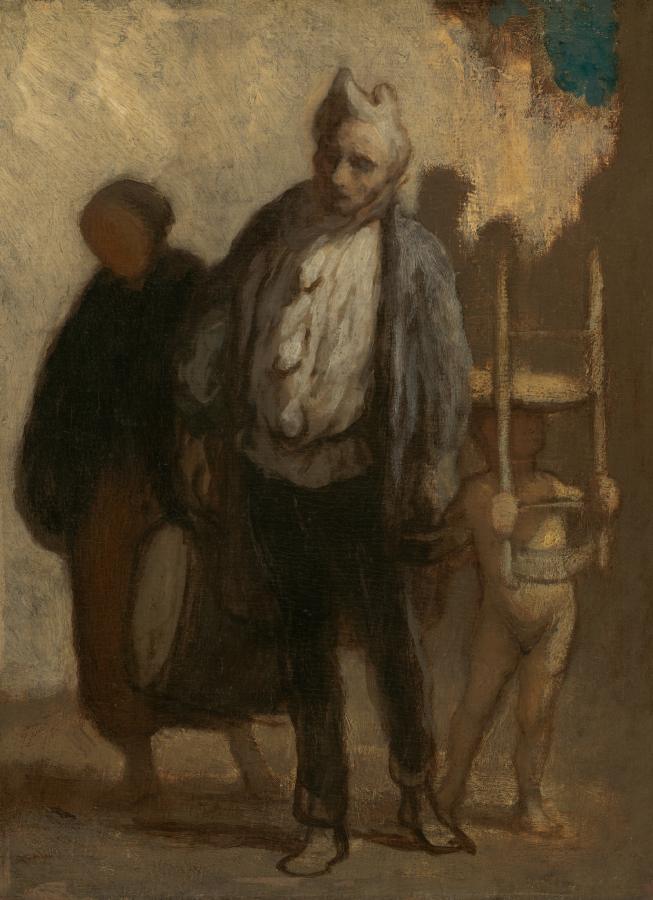Daumier, Honoré (1808-1879)
Saltimbanques errantes (Wandering Saltimbanques)
1847–1850
Oil on wood, 32.6 x 24.8 cm
National Gallery of Art, Washington
An older man, a woman, and a child who holds a chair upside-down on his head stand near each other in this vertical painting, which is made with dabs and strokes of muted grays, cream white, and golden tan. The scene is lit from our right, creating deep shadows. At the center of the composition, the man has light gray skin and he stands with his body angled slightly to our left, as he looks in that direction. His eyes are shaded and he has a round nose over a mouth mostly covered in shadow. His hat has two peaks like rounded horns and a smoke-gray scarf wraps around his neck. He wears a loose, cream-white shirt under a slate-blue jacket, and dark pants. His feet are loosely painted so it is difficult to tell if he is barefoot or if his shoes are sketchily painted. A rolled-up mat held under one arm and a small wooden box held with the other hand are loosely painted and nearly lost in shadow. To our right, just behind the man, the child wears a parchment-white, full body leotard with long sleeves and pants. His pale peach-colored hands grip the ladder back of the chair, which rests upside down on his head and casts his face into shadow. To our left, the woman is mostly in shadow. A peach-colored oval suggests her face and she wears a dark garment, perhaps a shawl, over a coffee-brown, ankle-length skirt. Her weight rests on her right foot, to our left, and she holds a large drum by her other side. The background is painted indistinctly with an area of bone white in the upper left corner, which stretches nearly across the composition along the top. Most of the rest is darker sand brown with a small patch of turquoise-blue paint near the upper right corner.
Best known for political cartoons and humorous caricatures satirizing contemporary life, Daumier‘s paintings reveal a more serious examination of the human condition. The itinerant street musicians and acrobats in Wandering Saltimbanques are depicted without ridicule, the artist sympathetically revealing the poverty and isolation of their offstage lives.
Daumier may have felt a personal affinity with the entertainers. The little boy carrying a chair could be a recollection of Daumier‘s childhood, when his family, destitute and living in Paris, endured numerous displacements to progressively worse lodgings. Further, it has been suggested that the older clown clad in traditional costume and leading his family in this painting may be associated with the artist’s father, a failed poet and playwright committed to the insane asylum at Charenton in 1851, where he died.
Daumier was self-taught as a painter, and his style has many characteristics of the graphic media in which he trained. The blunt silhouettes of the figures and the simplified space they occupy are stylistic elements that originated in his lithographs. The unspecific, indefinite appearance thus produced endows them with more universal meaning. Personal associations aside, the saltimbanques here are artists struggling to make their way in a world that, as Daumier depicts it, is a bleak, anonymous place. (NGA)
